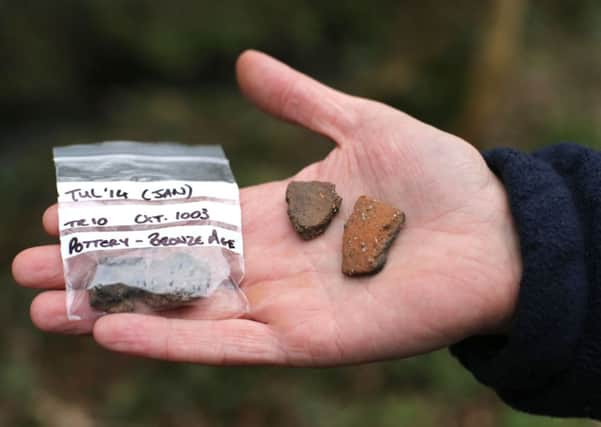Tullaghogue Fort artefacts date back over 7,000 years


Tullaghoge Fort between Cookstown and Dungannon was the place leaders of the dominant O’Neill clan came to be crowned from around the 14th Century to just before the arrival of the planters at the start of the 17th Century.
Targeted excavation work around the picturesque tree encircled earthen mound ahead of the planned development of new visitor facilities hoped to find and preserve buried artefacts from that period - but it ended up unearthing a lot more.
Advertisement
Hide AdAdvertisement
Hide AdArchaeologists have revealed that flint tool fragments have been found dating back before 5000 BC to the Mesolithic period when hunter gatherer settlers inhabited Ireland.
Dr John O’Keeffe, principal inspector of historic monuments at the Northern Ireland Environment Agency (NIEA), explained the significance of the surprise find.
“We were looking back 700 years and we got 7000, that would be a good way to put it,” said the expert.
“What we can now say is the hill where Tullaghoge stands was also being used and exploited by hunter gatherers - amongst the first people to settle on this island at all.”
Advertisement
Hide AdAdvertisement
Hide AdDr O’Keeffe said archaeologists had previously found evidence of prehistoric burial tombs at the present-day Mid Ulster Sports Arena in nearby Cookstown.
He said his teams were delighted to find evidence of settlements from the same era at Tullaghoge.
“I suppose when you think about it, it is not terribly far away from Lough Neagh and we tend to think of these hunter gatherer settlers following the river systems and then, depending on the season, either taking fish or coming on to land to take nuts, berries, seeds or to go after wild pig,” he said.
Dr O’Keeffe said the small pieces of flint would have been stuck to sticks using resin to make harpoons, spears or saws.
Advertisement
Hide AdAdvertisement
Hide AdAround 400 school children helped experts from the NIEA and Queen’s University, Belfast during two separate excavations.
Evidence of cereal harvesting on the site between the 7th and 9th centuries AD were also discovered.
Dr O’Keeffe said the new finds merely added to the rich story of a site more usually associated with the Medieval era and the time when the O’Neills ruled Ulster.
The Tullaghoge place name is taken to mean ‘Hill of the young warrior’ or ‘Hill of Youth’, from the Gaelic Tulloch Oc.